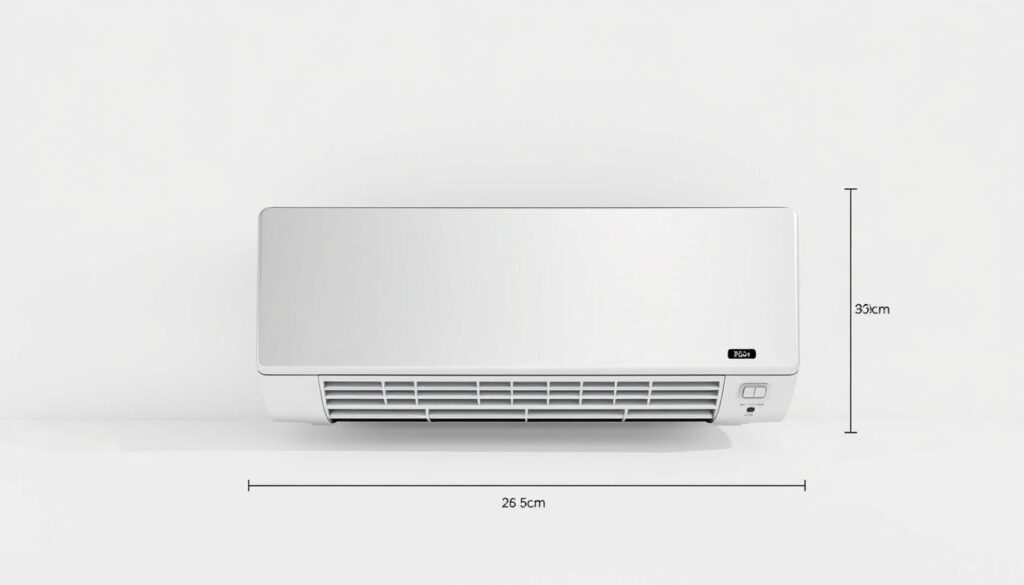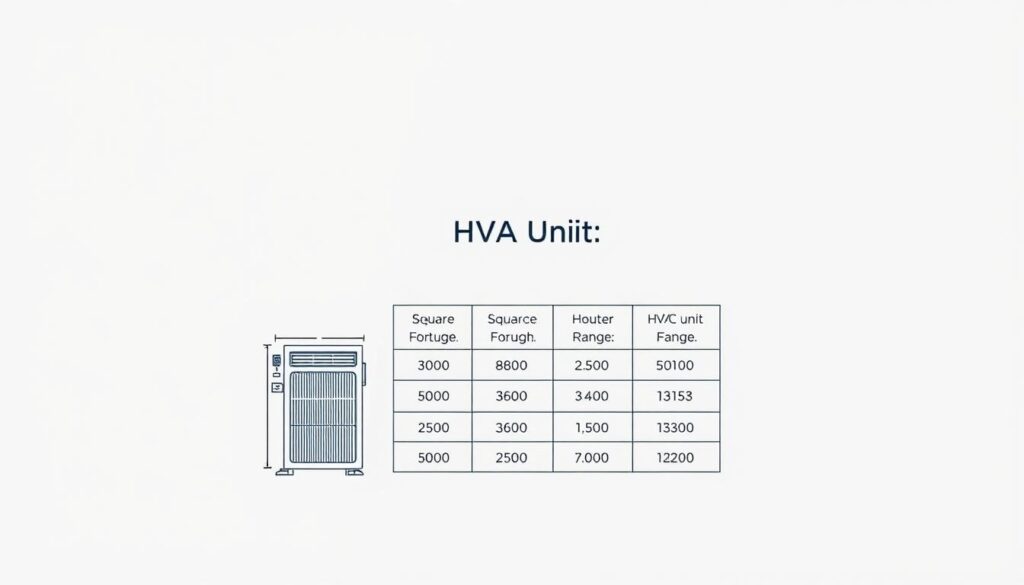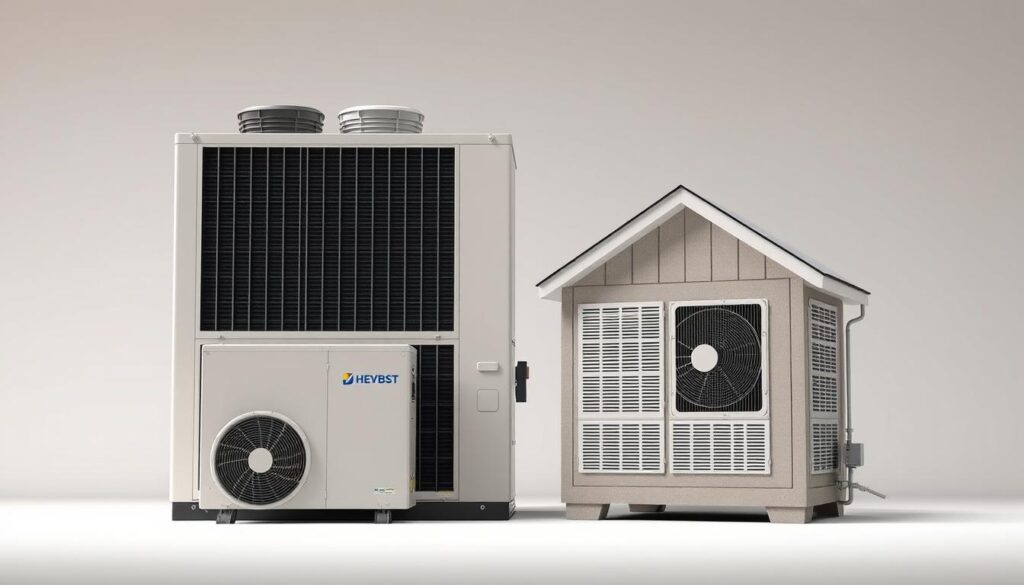Affiliate Disclosure
HVAC Guide Guys is a participant in the Amazon Services LLC Associates Program, an affiliate advertising program designed to provide a means for sites to earn advertising fees by advertising and linking to Amazon.
How Wide is an HVAC Unit? Ever wondered why choosing the right HVAC unit size feels like solving a complex puzzle? Understanding HVAC unit dimensions can be the key to creating the perfect indoor comfort environment for your home or business.

When exploring how wide an HVAC unit is, you’ll discover that these systems aren’t one-size-fits-all. HVAC unit dimensions vary dramatically based on system type, cooling capacity, and specific application requirements. Whether you’re a homeowner planning an installation or a professional contractor, knowing the precise width of your HVAC unit is critical for optimal performance.
This guide will walk you through everything you need to know about HVAC unit dimensions. It will help you make informed decisions about sizing, placement, and installation.
Key Takeaways
- HVAC unit sizes range widely depending on system type
- Accurate measurements are critical for efficient installation
- Residential and commercial units have different dimensional standards
- Proper sizing impacts overall system performance
- Climate and energy efficiency influence unit dimensions
Table of Contents
Understanding HVAC Unit Dimensions Basics
Knowing about HVAC unit measurements is key for keeping your home comfortable. The size of your HVAC system affects how well it heats and cools your space.
Measuring HVAC units isn’t just about their size. Experts use special terms and methods to find the perfect fit for your home.
Common HVAC Size Terminology
HVAC pros use certain terms to talk about unit sizes:
- BTU (British Thermal Unit): Shows how much the unit can cool or heat
- Tonnage: Tells you how much cooling power the unit has
- Square footage coverage
- Cubic feet per minute (CFM) of air movement
Why Unit Dimensions Matter
Choosing the right HVAC system size is important for comfort and saving energy. The wrong size can cause:
- Higher energy bills
- Uneven temperatures
- Shorter system life
Standard Measurement Methods
Experts use exact calculations to figure out the right unit size. They look at things like:
- Home size
- Ceiling height
- Insulation quality
- Local weather
Getting the right HVAC unit measurements is essential for a cozy and energy-saving home.
How Wide is an HVAC Unit: Standard Measurements
Knowing the width of an HVAC unit is key for proper installation and planning. The size varies a lot based on the system type and capacity. It’s important for homeowners and professionals to know the standard sizes for the best performance and fit.
When looking at HVAC unit width, there are a few important things to consider:
- Residential units usually range from 24 to 60 inches wide
- Commercial systems can be up to 100 inches or more wide
- Compact designs are getting more popular
Here are the standard width measurements for different HVAC systems:
| HVAC System Type | Typical Width Range | Common Applications |
|---|---|---|
| Central Air Conditioner | 24-36 inches | Residential homes |
| Heat Pump | 30-48 inches | Residential and light commercial |
| Packaged Unit | 36-60 inches | Larger residential and commercial spaces |
When picking an HVAC unit, think about these factors that affect width:
- Energy efficiency ratings
- BTU capacity
- Technological advancements
- Specific installation requirements
Modern HVAC technologies are moving towards more compact and space-efficient designs. Always talk to a professional to find the right unit width for your needs.
Explore Our HVAC Shop
Looking for top-rated HVAC tools, parts, and accessories? Visit our shop and find the perfect solution for your needs.
Visit the ShopTypes of HVAC Systems and Their Size Variations
Exploring the world of HVAC systems helps you choose the best for your home. Different sizes affect your comfort and energy use.
Today’s HVAC systems vary in size and design. Your system’s size depends on your home’s size, climate, and cooling needs.
Split System Dimensions
Split systems are common, with indoor and outdoor units. They come in various sizes:
- Indoor air handlers: 17-24 inches wide
- Outdoor condensing units: 24-36 inches wide
- Height variations: 24-48 inches
Packaged Unit Sizes
Packaged HVAC units are great for small spaces. They are all-in-one and usually:
- Width: 30-60 inches
- Depth: 24-36 inches
- Height: 36-48 inches
Ductless Mini-Split Measurements
Ductless mini-splits are flexible and space-saving. Indoor wall-mounted units are very compact:
- Width: 20-40 inches
- Height: 12-15 inches
- Depth: 6-10 inches
Choosing the right size HVAC system is key for your home’s comfort and energy savings.
Residential HVAC Unit Width Specifications
Knowing the width of your HVAC unit is key for homeowners. It affects how well your heating and cooling systems work. The right size is important for your home’s comfort.
Residential HVAC units vary in width based on several factors. They usually range from 24 to 60 inches wide. Most standard units are about 30-36 inches wide. Your unit’s width depends on:
- Home square footage
- Climate zone
- Cooling and heating needs
- Energy efficiency goals
Choosing the right HVAC unit is more than just looking at its width. The right size ensures optimal performance and energy efficiency. The wrong size can increase energy costs and reduce comfort.
Today, HVAC systems are getting more compact. Manufacturers are making units that are narrower but just as effective. This means you can find high-performance systems that save space in your home.
Pro tip: Always consult with a professional HVAC technician to determine the most appropriate unit width for your specific home requirements.
Remember, HVAC units are not one-size-fits-all. Your home’s unique needs will determine the best unit width and system design.
Explore Our HVAC Shop
Looking for top-rated HVAC tools, parts, and accessories? Visit our shop and find the perfect solution for your needs.
Visit the ShopSpace Requirements for HVAC Installation
When installing an HVAC system, it’s important to think about space. The right amount of room is key for good performance and safety. Your HVAC needs a certain amount of space to work well and keep your home safe.
Knowing what your HVAC system needs is vital. Different systems require different amounts of space. This affects how well they work and how long they last.
Minimum Clearance Guidelines
The space needed for HVAC systems varies. Here are some important guidelines:
- Central air conditioning units: Need at least 24 inches of space all around
- Heat pumps: Should have 18-24 inches of clear area
- Indoor air handlers: Best with 12-18 inches of space around them
Installation Location Considerations
Where you put your HVAC system matters a lot. Here are some tips for choosing the right spot:
- Outdoor units should be on flat ground
- Keep them away from direct sunlight and surfaces that reflect heat
- Make sure they’re not near debris or plants
Safety Distance Requirements
Keeping a safe distance from your HVAC system is important. It helps avoid problems like overheating and fire risks. Experts say to keep a certain distance to ensure everything works right.
| System Type | Recommended Safety Distance | Key Considerations |
|---|---|---|
| Central AC Unit | 24-36 inches | Prevent debris accumulation |
| Heat Pump | 18-24 inches | Ensure proper ventilation |
| Indoor Air Handler | 12-18 inches | Maintain access for maintenance |
Pro tip: Always talk to a professional HVAC technician. They can help figure out the best space needs for your system and home.
Size Guidelines Based on Home Square Footage

Choosing the right hvac unit size for your home is more than just square footage. While square footage is a good start, experts need to look at more details. They use special methods to make sure your hvac works well and saves energy.
Finding the right hvac system size is about more than just the size of your home. Experts use detailed calculations to figure out what your home really needs. This includes how much cooling and heating it needs.
| Home Square Footage | Recommended HVAC Unit Size (Tons) | Estimated BTU Capacity |
|---|---|---|
| 500-1,000 sq ft | 1-2 tons | 18,000-36,000 BTU |
| 1,000-1,500 sq ft | 2-3 tons | 36,000-54,000 BTU |
| 1,500-2,000 sq ft | 3-4 tons | 54,000-72,000 BTU |
| 2,000-2,500 sq ft | 4-5 tons | 72,000-90,000 BTU |
Important things to think about for accurate hvac sizing include:
- Ceiling height
- Insulation quality
- Number of windows
- Local climate conditions
- Home’s sun exposure
While these guidelines are helpful, getting a professional assessment is key. An hvac system that’s too big or too small can waste energy, cost more, and make your home less comfortable.
“Precision in HVAC sizing is not a luxury—it’s a necessity for home comfort and energy efficiency.” – HVAC Industry Expert
Always talk to a certified hvac professional. They can do detailed calculations for your home’s specific needs.
Explore Our HVAC Shop
Looking for top-rated HVAC tools, parts, and accessories? Visit our shop and find the perfect solution for your needs.
Visit the ShopFactors Affecting HVAC Unit Dimensions
Knowing what affects hvac unit dimensions helps you choose better heating and cooling systems. HVAC units come in different sizes, depending on several important factors.
Many parts influence the size and shape of your HVAC unit. Let’s look at the main factors that shape hvac unit dimensions:
BTU Capacity Impact
The British Thermal Unit (BTU) capacity affects your HVAC unit’s size. Units with higher BTU ratings need to be bigger. This is because they have more powerful cooling and heating systems.
- Low capacity (5,000-8,000 BTU): Compact units
- Medium capacity (10,000-14,000 BTU): Standard residential sizes
- High capacity (18,000-24,000 BTU): Larger, more robust systems
Climate Zone Considerations
Your location greatly affects your HVAC unit’s needs. Places with very hot or cold temperatures need stronger systems. These systems have different sizes.
| Climate Zone | Typical Unit Size | Key Characteristics |
|---|---|---|
| Hot, Humid Regions | Larger, more powerful units | Enhanced dehumidification capabilities |
| Cold Regions | Compact, high-efficiency units | Strong heating performance |
| Moderate Climates | Standard-sized units | Balanced cooling and heating |
Energy Efficiency Factors
Today’s HVAC systems focus on saving energy. High-efficiency models often have special parts that change how they’re sized.
When picking an HVAC system, think about these size factors. They help ensure your system works well, saves energy, and keeps you comfortable.
Commercial vs. Residential HVAC Unit Sizes

Commercial and residential HVAC systems are very different. They need unique approaches to size, with commercial units often being more complex.
Commercial HVAC systems have special features:
- Larger size to cover more space
- More modular design for easy setup
- Higher capacity for many zones and people
- Special rooftop units
The size of commercial HVAC units depends on several things:
- Building size
- Number of people using it
- Presence of heat-generating equipment
- Specific needs of the industry
Residential HVAC systems focus on home comfort. They usually range from 1.5 to 5 tons. Commercial systems can go over 20 tons for big buildings.
Experts say precise calculations are key to finding the right system size for your needs.
Knowing the differences helps you choose the best HVAC system for your space. This ensures comfort and saves energy.
HVAC Unit Placement and Space Planning
Choosing the right spot for your HVAC unit is key for its best performance and life span. It’s not just about finding a free space. Good planning can make your system work better, be easier to maintain, and keep your home comfy.
When picking a spot for your HVAC, think about a few important things:
- Easy access for upkeep and fixes
- How to keep noise down
- Making it look good with your home
- Shielding it from harsh weather
Outdoor units do best in spots with:
- Good air flow
- Less direct sun
- Safe from leaves and plants
- Flat ground
For indoor units, you need to think carefully too. You want to avoid things that might block air flow or make the system less efficient.
| Placement Location | Recommended Clearance | Performance Impact |
|---|---|---|
| Outdoor Unit | 24-36 inches | Best air flow |
| Indoor Unit | 12-18 inches | Good cooling and heating |
| Utility Room | At least 30 inches | Easy to get to for maintenance |
Pro tip: Always talk to a pro HVAC tech to find the best spot for your system and home layout.
Explore Our HVAC Shop
Looking for top-rated HVAC tools, parts, and accessories? Visit our shop and find the perfect solution for your needs.
Visit the ShopModern HVAC System Size Trends
The world of HVAC units is changing fast. Makers are making them smaller, smarter, and more powerful. Your home’s heating and cooling systems are getting a big upgrade.
New ideas in HVAC system size are changing home comfort. Tech advancements are leading to smaller, yet powerful systems. These changes make your home more comfortable without taking up too much space.
Compact Design Innovations
Manufacturers are making big changes in HVAC system size. They’re using new designs to make systems smaller and more efficient:
- Miniaturized component technology
- Advanced material engineering
- Modular system configurations
- Integrated smart control mechanisms
Space-Saving Technologies
Modern HVAC tech focuses on being smaller but more powerful. Ductless mini-split systems are a great example. They’re easy to install and super efficient, perfect for small spaces.
Future Size Predictions
Experts say HVAC units will keep getting smaller. The future looks bright with systems that are:
- 50% smaller than today’s models
- Connected to smart homes
- More energy-efficient
- Flexible for different homes
As tech keeps improving, your HVAC system will become even more advanced. It will be a key part of making your home comfortable.
Conclusion
Knowing how wide an HVAC unit is is key for home and business climate control. Choosing the right size affects how well it works, saves energy, and keeps you comfortable. Experts say to measure carefully before installing to get the best results.
When looking at HVAC unit sizes, think about more than just width. Things like climate, home size, BTU needs, and new tech are important too. Today’s HVAC systems are getting smaller and more efficient, using less space but keeping your place cool.
Planning for an HVAC unit means more than just measuring its width. You also need to think about space around it, where it goes, and future tech upgrades. Talking to HVAC pros can guide you to the right choice for your space and needs.
As HVAC tech gets better, units will likely get smaller and smarter. Learning about these details can make your home more comfortable, cut down on energy bills, and help the planet.

